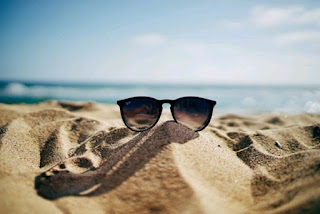Summer is here, and it feels long overdue. Queue barbecues and outdoor get-togethers. Say hello to the sun's rays waking you up in the morning, encouraging you to start the new day. Rejoice at the prospect of lounging on a sunbed as waves gently remind you to relax and take a sip of that refreshing beverage in your hand. Immerse yourself in numbers as you calculate how much you will need to fix that faulty air-conditioner and install new blinds. Wait...what? There are certain touch-ups and renovations every home needs, be it summer or winter. To save money, you may want to do it on your own. For example, checking if your HVAC is summer-ready is a responsible step to take. However, you must know how to be safe when doing home projects during these summer months. Not 100% sure? Don't worry; we've got you!
'S' stands for summer
 |
| Can you find all the summer words starting with the letter 's'? |
See the sultry sky, sunrays skipping over silent, see-through clouds, as you discover serenity in the shade of a tree during this sizzling season of sun-kissed days, sandals, seashells, and sandcastles. Acknowledged - alliteration was never my strong suit, but one word stands out above the others. Safety. On this note, a slight digression could be in order. You should avoid doing some renovations on your own, altogether, as they require more than just goodwill. The tips in this article are not enough to overcome the difficulties these particular tasks pose.
In any case, no matter what part of the year you have chosen to carry out your home projects, you need to take care of yourself. The summer takes away the cold and rainy weather but brings a host of new challenges, the chief one amongst them being the summer heat. As the thermometer threatens to shatter its glass casing, it is essential to remember that our bodies are prone to overheating. We are prone to dehydration. The number one rule should be to always have a bottle of water at the ready. Whatever project you have chosen to keep you occupied during the summer months, a glass of the old Adam's ale should be the first tool you pick up. Summertime safety simply states stay saturated...ok, ok, I'll stop!
Get out of the heat and stay safe when tackling your home projects this summer!
 |
| Shade and rest- essential to be safe when doing home projects this summer |
Now that we have regulated our water intake, there are still other dangers that come with the summer sun. Heatstroke and heat exhaustion are not to be taken lightly. Why? We often think we can handle more than we really can. It's nothing to be ashamed of; we're almost hard-wired to act like this. DIY is in our DNA, and there is no better feeling than pushing yourself to the limit. Until, you know, you actually pass that limit. So taking rests is a must. That porch won't mind if it's fixed today or in three days. Your body will be thankful if you treat it right. The work will be more effective, and you will be healthier and feel better if you break up the work into manageable chunks.
There is a third part that makes up this holy trinity of sorts when it comes to working safely on your home projects during the summer. And wouldn't you know it, it starts with an 's'. Shade is the final missing piece. Stay out of direct sunlight, as it's always cooler in the shade.
One thing should be noted, despite all that has been said. Don't think you get to leave the old safety goggles, gloves, and a hat in the garage because it is hot. If the project calls for it, the full gear should be worn. It just means taking more regular breaks is in order.
Summer moves
Nothing quite like a good summer jam, something to move to during those beach parties. However, many people choose this time of the year to move a bunch of boxes too. If you have decided to relocate during the summer, a look at the sweltering heat outside could leave you second-guessing your decision. It looked good on paper, but now you are not so sure. There are reasons for and against moving in the summertime. While it holds true that you should be careful when relocating in heat, a quick look at the pros and cons could help you make your final decision. Don't forget; there was a reason you chose to avoid moving during an icy winter's day, after all.
Be safe when doing home projects this summer and all year round
You will find that at the heart of most things, there is a set of basic rules. If we put aside differences in weather conditions, most of what applies to frosty February is applicable to ardent August as well. We've organized these tips into a neat little list, just for you:
- First Aid Kit- As a rule of thumb, you should always have a first aid kit, especially if you live alone. All handymen keep one on hand.
- Choose your battles- Not all tasks should be done on your own. Faulty wiring? Ask yourself, do you have the needed equipment and expertise to handle it safely? Have to plan a big move quickly? Maybe professionalmover.ca could be the better way to go.
- Awareness of your surroundings- Yes, it sounds like the cliched advice given to a young apprentice by his master in any given action movie, but this one holds true in real life too. Your workspace is your dojo, if you will. You need to know who is there and where your tools are around the work area. Maybe putting a ladder in front of a door in a house full of kids, for example, is an accident waiting to happen.
- Keep a clean shop- We've all heard about the importance of cleanliness. Keeping your workspace organized and tidy means you avoid possible accidents. Unless you're a certain kid protecting your home from burglars, power tools and sharp objects should never be left lying around the house. Do everything in your power to stay safe this summer when undertaking different projects around the house.
- Slow and steady wins the race- There is no need to rush, especially during the summer. Take advantage of those long, long days.
A safe summer is a fun summer
 |
| A good day's work makes the sunset all the more enjoyable |
The above tips should help you stay safe as you tackle those odd jobs around the house. These rules are not here to suck the fun out of your undertakings but simply to give you some pointers on how to be safe when doing home projects this summer. With all that added sunlight, why not fix the front porch, clean that AC unit, and still have a glass of refreshing ice lemonade with your neighbors on the patio?
P.S. The answer to the question under the first photo was; sunglasses, shade, sea, sky, and sand...thought I'd leave that here for the more competitive of you out there.
Photos:
https://unsplash.com/photos/lbbGlDBN0PA
https://unsplash.com/photos/SYx3UCHZJlo
https://unsplash.com/photos/bc0iMVs7U3A
https://unsplash.com/photos/uPuOZaFdApQ
















